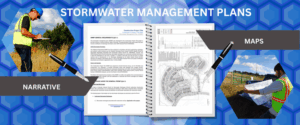Stormwater Management Plans (SWMPs) in Colorado Explained

Once you understand the basics of stormwater compliance (reference our previous blog What is Stormwater Compliance), the next step is to create a plan that outlines how you’ll meet the requirements and remain compliant. In Colorado, this plan is called a Stormwater Management Plan (SWMP)—known in other regions as a Stormwater Pollution Prevention Plan (SWPPP). The SWMP is a living, detailed document that describes the site, project activities, and the measures in place to manage stormwater runoff and prevent it from carrying pollutants off-site. This blog builds on the concepts covered in our “What’s in a SWMP?” post, so be sure to check that out for a deeper dive into each component.
In Colorado, a SWMP is required by the CDPS Construction Stormwater General Permit (Permit COR400000), which is administered by the Colorado Department of Public Health and Environment (CDPHE) Water Quality Control Division (WQCD). It’s important to note that projects must comply not only with the CDPS permit, but also with local municipal stormwater programs (e.g., MS4 permittees like City and County of Denver, Aurora, or Fort Collins may have stricter requirements).
A SWMP will consist of two components: a narrative and maps. The narrative is the written portion of your SWMP that explains how your site will comply with stormwater regulations. It provides a clear overview and description of the project activities, site conditions, potential pollutant sources, and the Best Management Practices (BMPs) that will be used to control runoff. The narrative ties all parts of the SWMP together in a cohesive written form.
The maps section includes the Erosion Control Plan (typically drawn up with the Civil Drawing Set). These maps will show what BMPs will be installed, where, and during what phase of construction. The phases typically include pre-construction, interim, and final phase maps.
So who’s responsible for compiling the SWMP? The responsibility for compiling a SWMP ultimately depends on the project structure, but here’s how it’s typically broken down:
- Permittee (Owner/Developer)
The owner or developer listed on the CDPS Construction Stormwater Permit (the permittee) is legally responsible for ensuring the SWMP is prepared, implemented, and kept up to date.
- SWMP Preparer / Qualified Stormwater Professional
The actual writing and compilation of the SWMP is often done by a Qualified Stormwater Professional (QSP) or environmental consultant. This person develops the narrative, site maps, and BMP details, tailoring the plan to the site’s conditions and construction activities. They must make sure the plan meets state and local requirements and that it’s available on-site at all times.
- Contractor / Site Superintendent
The contractor or site superintendent is responsible for implementing and maintaining the BMPs outlined in the SWMP. They must also ensure inspections, recordkeeping, and updates occur as the project evolves.
In summary, the permittee is legally responsible for the SWMP, but a qualified stormwater professional usually writes it, and the contractor ensures it’s followed and kept current in the field. The SWMP must be kept on-site (or electronically accessible) and made available to CDPHE inspectors upon request.
Request a SWMP and compliance services proposal for your project today!
